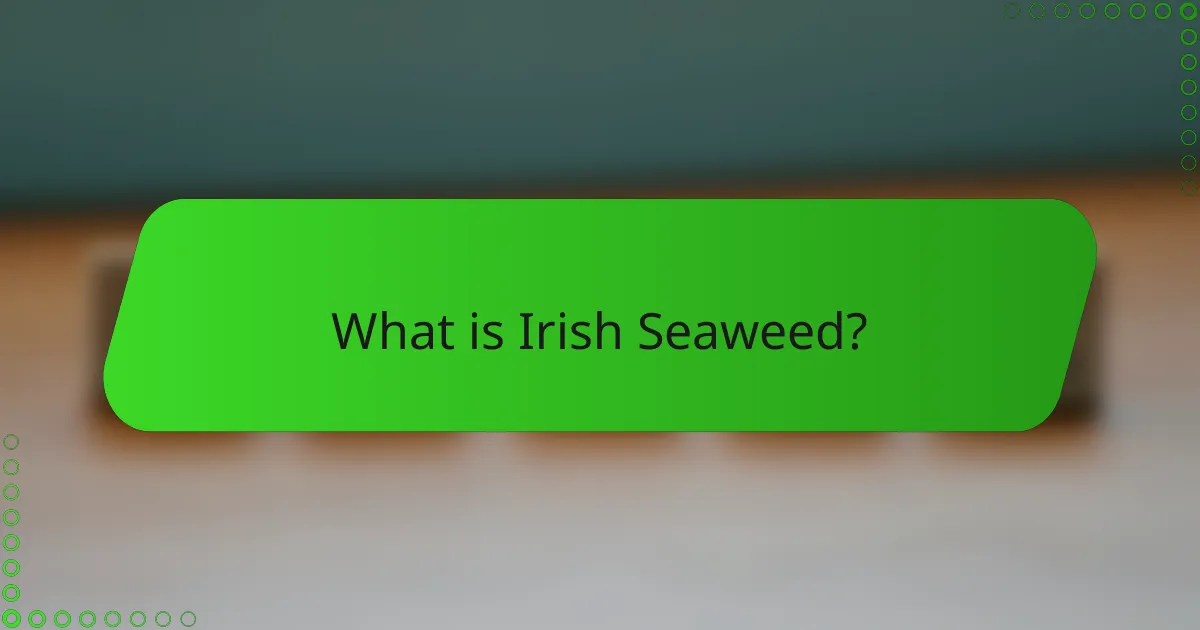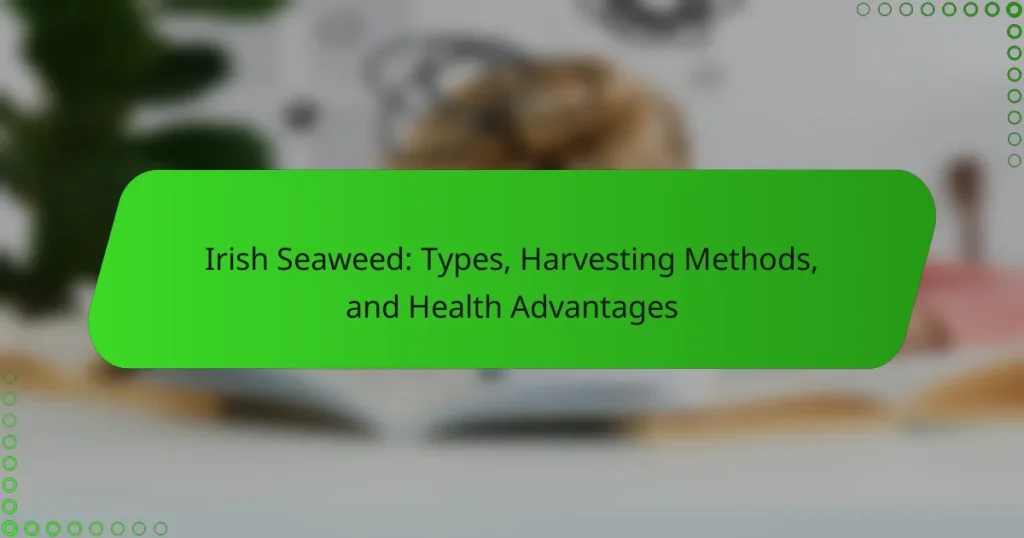Irish seaweed, a type of marine algae found along the coasts of Ireland, includes notable species such as Carrageen moss and Dulse. It is known for its rich nutrient profile, containing vitamins, minerals, and antioxidants that support health benefits like thyroid function and gut health. Various harvesting methods, including hand harvesting, mechanical harvesting, and underwater diving, are employed to collect Irish seaweed, each with its unique advantages. The consumption of Irish seaweed is associated with improved skin health, digestive health, and potential weight management benefits due to its fiber content and anti-inflammatory properties.

What is Irish Seaweed?
Irish seaweed is a type of marine algae found along the coasts of Ireland. It includes various species, such as Carrageen moss and Dulse. Irish seaweed is rich in nutrients, including vitamins, minerals, and antioxidants. It has been used traditionally in Irish cuisine and herbal medicine. Research indicates that it may offer health benefits, such as supporting thyroid function and improving gut health. The unique coastal environment of Ireland contributes to its distinct flavor and nutritional profile.
How is Irish Seaweed classified?
Irish seaweed is classified into three main groups: red, green, and brown algae. Red algae belong to the Rhodophyta division. Green algae are part of the Chlorophyta division. Brown algae fall under the Phaeophyta division. Each group has distinct characteristics and ecological roles. For example, red algae often contain phycoerythrin, which gives them their color. Green algae are typically found in shallow waters. Brown algae can grow in deeper ocean environments. This classification is based on their pigmentation, structure, and habitat.
What are the main types of Irish Seaweed?
The main types of Irish seaweed include kelp, dulse, and carrageen. Kelp is a large brown seaweed known for its high iodine content. Dulse is a red seaweed, often used in snacks and soups, rich in protein and vitamins. Carrageen, also known as Irish moss, is a gelatinous red seaweed used as a thickening agent in food products. Each type offers unique nutritional benefits and culinary uses.
What are the unique attributes of each type of Irish Seaweed?
Irish seaweed includes several types, each with unique attributes. Ascophyllum nodosum, commonly known as knotted wrack, is rich in alginates and iodine. Chondrus crispus, or Irish moss, contains carrageenan, which is used as a thickening agent. Laminaria digitata, known as sugar kelp, has a high mineral content, particularly potassium. Fucus vesiculosus, also called bladderwrack, is noted for its high antioxidant levels. Porphyra, commonly referred to as nori, is high in protein and vitamins A, C, and E. Each type offers distinct nutritional benefits and culinary uses, emphasizing the diversity of Irish seaweed.
Why is Irish Seaweed significant in culture and cuisine?
Irish Seaweed is significant in culture and cuisine due to its historical use and nutritional benefits. Traditionally, it has been a staple food source in coastal communities in Ireland. Irish Seaweed is rich in vitamins and minerals, making it a valuable dietary component. It has been used in various dishes, including soups and salads, enhancing flavor and nutrition. The harvesting of Irish Seaweed is often a community activity, reflecting cultural traditions. Additionally, it plays a role in modern culinary practices, including gourmet cooking and health foods. Its significance is also highlighted in traditional Irish folklore and herbal medicine.
How has Irish Seaweed been used historically?
Irish seaweed has been used historically as a food source, fertilizer, and medicine. It has been a staple in the Irish diet for centuries, providing essential nutrients. Seaweed was often harvested from rocky shorelines by coastal communities. It was consumed fresh, dried, or cooked in various dishes. Additionally, Irish seaweed served as a natural fertilizer for crops due to its rich mineral content. Medicinally, it was used to treat various ailments, including respiratory issues and skin conditions. Historical records indicate that seaweed’s uses date back to ancient times, with evidence of its consumption in prehistoric Ireland.
What culinary applications does Irish Seaweed have?
Irish seaweed is widely used in culinary applications across various cuisines. It serves as a natural thickening agent in soups and stews. Chefs incorporate it into salads for added texture and flavor. Irish seaweed is also used to create flavorful broths in seafood dishes. It can be dried and ground into a powder for seasoning. Additionally, it enhances the nutritional value of dishes due to its high mineral content. Its umami flavor profile complements many savory recipes. Various types, such as dulse and carrageenan, are popular in cooking. These applications highlight its versatility and health benefits in gastronomy.

What are the methods of harvesting Irish Seaweed?
Irish seaweed is harvested using various methods. The primary methods include hand harvesting, mechanical harvesting, and underwater diving. Hand harvesting involves collecting seaweed by hand during low tide. This method is labor-intensive but allows for selective harvesting. Mechanical harvesting uses specialized equipment to cut and collect seaweed from the sea floor. This method is faster and more efficient for large quantities. Underwater diving allows divers to gather seaweed directly from the ocean. This method provides access to deeper seaweed beds. Each method has its advantages and is chosen based on the specific type of seaweed and the harvesting location.
How is Irish Seaweed traditionally harvested?
Irish seaweed is traditionally harvested by hand during low tide. Harvesters wade into the intertidal zone to collect the seaweed. They use simple tools like knives or sickles to cut the seaweed from rocks. This method preserves the ecosystem and allows for sustainable harvesting. Historically, communities have relied on this practice for food and medicinal purposes. The timing of the harvest is crucial, as it is best done in spring and early summer. This period ensures the seaweed is at its most nutritious. Traditional methods have been passed down through generations, emphasizing respect for nature.
What tools and techniques are used in traditional harvesting?
Traditional harvesting of Irish seaweed involves specific tools and techniques. Common tools include sickles, knives, and rakes designed for seaweed collection. Harvesters often use baskets or nets to gather the seaweed efficiently. Techniques include hand-harvesting during low tide to access exposed seaweed beds. This method minimizes environmental impact and ensures sustainable practices. Historical records indicate that these methods have been used for centuries in coastal communities. Additionally, the timing of harvest is crucial, as it aligns with the seaweed’s growth cycles. These practices reflect a deep understanding of marine ecosystems and sustainable harvesting.
What are the best practices for sustainable harvesting?
Best practices for sustainable harvesting include assessing the ecosystem before harvesting. This ensures the health of the seaweed population. Harvesters should only collect a portion of the seaweed, typically no more than 30%. This allows for regrowth and maintains the habitat. Timing is crucial; harvesting should occur during peak growth seasons. This maximizes yield while ensuring sustainability. Additionally, using proper techniques minimizes damage to the surrounding environment. Training and educating harvesters on sustainable practices is essential. Monitoring and regulating harvest levels helps maintain balance in the ecosystem. Following these practices supports long-term viability of seaweed resources.
What modern methods are used for harvesting Irish Seaweed?
Modern methods for harvesting Irish seaweed include mechanical harvesting, hand harvesting, and underwater farming techniques. Mechanical harvesting uses specialized boats equipped with cutting and collecting machinery. This method allows for efficient large-scale collection of seaweed. Hand harvesting is performed by divers or waders who manually collect seaweed from rocks or shallow waters. This method is often used for premium seaweed varieties. Underwater farming involves cultivating seaweed on ropes or nets in controlled environments. This method ensures sustainable growth and reduces overharvesting of wild populations. These modern techniques enhance the efficiency and sustainability of seaweed harvesting.
How do modern techniques differ from traditional methods?
Modern techniques for harvesting Irish seaweed differ from traditional methods primarily in efficiency and sustainability. Traditional methods often relied on manual harvesting, which was labor-intensive and time-consuming. Modern techniques utilize mechanized equipment, allowing for faster collection and processing.
These advancements reduce labor costs and increase yield per hour. Additionally, modern methods often incorporate sustainable practices, such as selective harvesting. This minimizes environmental impact, ensuring that seaweed populations can regenerate effectively.
Research indicates that mechanized harvesting can improve the quality of seaweed by reducing damage during collection. Studies have shown that modern techniques can enhance nutrient retention in harvested seaweed. This shift towards efficiency and sustainability marks a significant evolution in the industry.
What technologies are employed in the harvesting process?
The technologies employed in the harvesting process of Irish seaweed include mechanical harvesters and manual tools. Mechanical harvesters are used to efficiently collect large quantities of seaweed from the ocean floor. These machines can cut, gather, and transport seaweed simultaneously. Manual tools, such as rakes and knives, are utilized for smaller-scale harvesting. Divers may also be involved in hand-harvesting techniques. These methods ensure minimal damage to the marine ecosystem. Research indicates that sustainable practices are essential for the long-term viability of seaweed harvesting.

What health advantages does Irish Seaweed offer?
Irish Seaweed offers numerous health advantages. It is rich in vitamins and minerals, including iodine, calcium, and iron. These nutrients support thyroid function and boost metabolism. Irish Seaweed also contains antioxidants, which help combat oxidative stress. Studies have shown that its fiber content promotes digestive health. Additionally, it may aid in weight management by enhancing satiety. Research indicates that compounds in Irish Seaweed can have anti-inflammatory effects. Its consumption is linked to improved skin health due to its nutrient profile. Thus, incorporating Irish Seaweed into the diet can provide various health benefits.
What nutritional benefits does Irish Seaweed provide?
Irish Seaweed is rich in essential nutrients and offers numerous health benefits. It contains vitamins A, C, E, and K, which support immune function and skin health. Irish Seaweed is also a good source of dietary fiber, aiding digestion and promoting gut health. Additionally, it provides minerals such as iodine, calcium, magnesium, and potassium, crucial for thyroid function and bone health. Research indicates that the high antioxidant content in Irish Seaweed can help reduce inflammation and combat oxidative stress. Studies show that its consumption may enhance metabolic health and support weight management.
How does Irish Seaweed contribute to a balanced diet?
Irish Seaweed contributes to a balanced diet by providing essential nutrients and minerals. It is rich in vitamins A, C, E, and K, which support various bodily functions. Additionally, Irish Seaweed contains iodine, crucial for thyroid health. The fiber content aids digestion and promotes gut health. Seaweed is low in calories, making it a healthy addition to meals. Studies show that it can help lower cholesterol levels and support heart health. Its antioxidant properties may reduce inflammation and protect against chronic diseases. Overall, incorporating Irish Seaweed can enhance nutritional intake and promote overall well-being.
What specific vitamins and minerals are found in Irish Seaweed?
Irish seaweed contains a variety of vitamins and minerals. Key vitamins include vitamin A, vitamin C, vitamin E, and several B vitamins such as B1, B2, and B9. Important minerals found in Irish seaweed are iodine, calcium, magnesium, potassium, and iron. The iodine content is particularly high, which is essential for thyroid function. Additionally, the presence of calcium supports bone health. Magnesium contributes to muscle and nerve function. Potassium aids in maintaining fluid balance. Iron is crucial for oxygen transport in the blood. These nutrients contribute to the overall health benefits associated with consuming Irish seaweed.
How does Irish Seaweed support overall health?
Irish seaweed supports overall health through its rich nutrient profile. It is high in vitamins, minerals, and antioxidants. Irish seaweed contains iodine, which is essential for thyroid function. It also provides dietary fiber, promoting digestive health. The antioxidants in seaweed can help reduce inflammation. Studies show that seaweed may support heart health by lowering cholesterol levels. Additionally, it can enhance skin health due to its hydrating properties. Research indicates that the bioactive compounds in seaweed may have anti-cancer effects. Overall, Irish seaweed is a valuable addition to a balanced diet for promoting health.
What role does Irish Seaweed play in digestive health?
Irish Seaweed supports digestive health primarily through its high fiber content. This fiber aids in regular bowel movements and helps prevent constipation. Additionally, Irish Seaweed contains prebiotics that promote the growth of beneficial gut bacteria. These bacteria enhance digestion and improve nutrient absorption. Studies indicate that the alginate found in seaweed can reduce gastric acid and promote gut health. Furthermore, Irish Seaweed is rich in vitamins and minerals that contribute to overall digestive function. Its consumption may alleviate digestive issues such as bloating and discomfort.
How can Irish Seaweed benefit skin health?
Irish Seaweed can significantly benefit skin health. It is rich in vitamins, minerals, and antioxidants. These nutrients help to hydrate and nourish the skin. Irish Seaweed contains alginates, which provide a protective barrier against environmental stressors. This barrier can prevent moisture loss, keeping the skin supple. Additionally, it has anti-inflammatory properties that can soothe irritated skin. Studies show that seaweed extracts improve skin elasticity and reduce the appearance of fine lines. Furthermore, its antibacterial properties can help prevent acne. Overall, Irish Seaweed is a valuable ingredient for maintaining healthy skin.
What are practical ways to incorporate Irish Seaweed into your diet?
Add Irish seaweed to salads for a nutrient boost. It provides vitamins and minerals like iodine and calcium. Use dried seaweed as a seasoning in soups or stews. This enhances flavor and adds fiber. Incorporate seaweed into smoothies for added nutrition. Blend it with fruits for a nutritious drink. Use seaweed in sushi rolls as a wrap. This is a traditional method that adds taste. Cook seaweed with grains like rice or quinoa. This creates a wholesome dish with added nutrients. Snack on roasted seaweed sheets for a healthy alternative. They are low in calories and high in minerals.
What recipes can you try using Irish Seaweed?
You can try various recipes using Irish seaweed, including soups, salads, and snacks. For example, seaweed can be added to miso soup for umami flavor. It can also be used in salads for added texture and nutrients. Another option is to make seaweed crisps by baking it with oil and seasonings. Seaweed can be incorporated into smoothies for a nutrient boost. Additionally, it can be used as a seasoning for rice or grain dishes. These recipes highlight the versatility of Irish seaweed in culinary applications.
How can you source high-quality Irish Seaweed for consumption?
To source high-quality Irish Seaweed for consumption, seek reputable suppliers specializing in seaweed products. Look for organic certifications to ensure quality and safety. Research local seaweed farms in Ireland, as they often provide fresh, sustainably harvested options. Online retailers also offer a variety of seaweed types, but verify their sourcing practices. Read customer reviews to assess product quality and supplier reliability. Additionally, consider seaweed that has been tested for contaminants, ensuring it is safe for consumption. High-quality Irish seaweed is typically bright in color and has a fresh ocean scent.
Irish seaweed is a type of marine algae found along the coasts of Ireland, encompassing various species such as Carrageen moss and Dulse, known for their rich nutrient profiles and culinary uses. The article explores the classification of Irish seaweed into red, green, and brown algae, highlighting main types like kelp and dulse, each with unique attributes and health benefits. It details traditional and modern harvesting methods, emphasizing sustainable practices, and discusses the numerous health advantages, including support for thyroid function, digestive health, and skin health. Additionally, practical ways to incorporate Irish seaweed into the diet and sourcing high-quality products are provided, showcasing its versatility and significance in Irish culture and cuisine.


